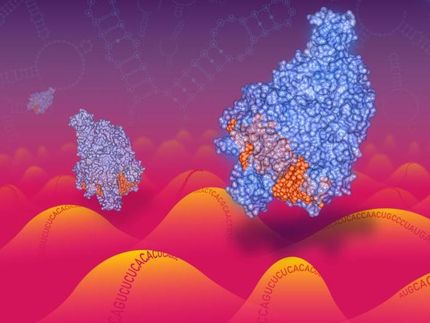Temperature controls the genetic message
A team of scientists at the CSIC has shown that temperature can play a critical role in the control of splicing. The team led by Josep Vilardell, ICREA scientist at the CSIC's Molecular Biology Institute of Barcelona, has demonstrated that temperature, through its effects on RNA structure, can control how the genetic information will be processed. The results of this work are published in Molecular Cell.
Hiding intronic cues
For some time, scientists have been trying to understand how the spliceosome -the molecular 'machine' responsible for splicing- works to generate a mRNA (messenger RNA) with capacity for generating the right protein. During splicing, the spliceosome selects internal sequence fragments, in a process where it cuts the RNA genetic sequence at specific points: the endings of the introns. Then, it joins the fragments to generate the new mRNA.
It is known that errors in splicing can be lethal. The question is, Vilardell points out, "how does the splicesome choose the right intronic endings? We have tried to find out an answer with the yeast Saccharomyces cerevisiae. It has a small and well characterized genome, with a reduced set of known introns. This helped us to simplify our approach".
With their work, researchers have found that within a small range of temperature, from 23 to 37 C degrees, some yeast RNAs change their structure, either hiding or showing particular sequences. As the splicesome uses all the cut points that are accessible, but not the ones that are hidden, the result is that the intron is differently recognized, which eventually will generate two different proteins.
Scientists have shown that temperature and the inherent RNA flexibility allows for "an autonomous strategy of control of RNA processing. It was known that temperature affects RNA structure, and now we find that this has important consequences for the splicing".
What are the implications of this alternative RNA processing? Vilardell explains that "in the yeast gene where we have found this, the hypothesis is that this phenomenon affects the stability of the encoded protein or its capacity for interacting with other molecules."
Now, adds Vilardell, "we are very interested in studying what happens in other, more complex, organisms. There is no reason to think that this strategy is not used in mammals, where the effects could be more relevant from the health perspective".
There are situations where our organism changes temperature, and a specific splicing for these situations could be taking place. Maybe the most obvious example is when we have a fever, says Vilardell. Some RNAs may have acquired the capacity to respond to subtle temperature variations through small structure changes. In addition, there are biological processes that need a specific temperature (such as the spermatozoid production) and optimal genetic expression could use a proper folding of the RNAs of the genes that are specifically expressed.
Another scenario is centered on the need of a quick adaptation of gene expression to sudden changes in temperature. "This implies the generation of new protein isoforms, as well as of RNAs that have lost their coding potential, avoiding the synthesis of proteins that could be harmful under these conditions. Our data show that this quick response can be mediated by the RNA structure itself".
Other news from the department science

Get the life science industry in your inbox
By submitting this form you agree that LUMITOS AG will send you the newsletter(s) selected above by email. Your data will not be passed on to third parties. Your data will be stored and processed in accordance with our data protection regulations. LUMITOS may contact you by email for the purpose of advertising or market and opinion surveys. You can revoke your consent at any time without giving reasons to LUMITOS AG, Ernst-Augustin-Str. 2, 12489 Berlin, Germany or by e-mail at revoke@lumitos.com with effect for the future. In addition, each email contains a link to unsubscribe from the corresponding newsletter.


















































